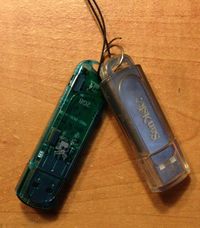Thumb drive
Dan Tobias (Talk | contribs) |
Dan Tobias (Talk | contribs) (→References) |
||
| (9 intermediate revisions by one user not shown) | |||
| Line 1: | Line 1: | ||
{{FormatInfo | {{FormatInfo | ||
|formattype=physical | |formattype=physical | ||
| + | |image=Thumbdrives.jpg | ||
| + | |caption=Two thumb drives | ||
}} | }} | ||
| − | A '''thumb drive''', or '''USB flash drive''', is a small device which can be inserted into a [[USB]] port in a computer or other electronic device in order to provide storage or transfer of data. It resembles a disk drive to the computer, but has no moving parts. They are widely used due to their compact size (smaller than a floppy disk or CD) and high storage capacity (as much as | + | A '''thumb drive''', or '''USB flash drive''', is a small device which can be inserted into a [[USB]] port in a computer or other electronic device in order to provide storage or transfer of data. It resembles a disk drive to the computer, but has no moving parts; [[flash memory]] is used. They are widely used due to their compact size (smaller than a floppy disk or CD) and high storage capacity (as much as [http://www.kingston.com/us/company/press/article/6487 a terabyte] now). The memory is nonvolatile, so it will hold its data indefinitely just like a disk, and is freely readable and writable like a floppy or hard disk. |
| − | Many varieties of thumb drives exist with different data capacities. | + | Many varieties of thumb drives exist with different data capacities. Often the [[ExFAT]] filesystem is used to organize data on them. |
| + | |||
| + | Because the thumb drive is an electronic device with some in-built intelligence of its own which responds to read and write requests, it is possible to create "hacked" drives which do unusual things such as wipe themselves out if unwanted data retrieval events take place. Such techniques are discussed in a video lecture linked below. | ||
== References == | == References == | ||
* [[Wikipedia:USB flash drive|Wikipedia article]] | * [[Wikipedia:USB flash drive|Wikipedia article]] | ||
* [http://www.youtube.com/watch?v=ijyAwxH_iok Writing a thumbdrive from scratch]: Video lecture describing "hacking" the low level of a thumb drive and its firmware and interfaces, for such purposes as hiding your data from forensic scans | * [http://www.youtube.com/watch?v=ijyAwxH_iok Writing a thumbdrive from scratch]: Video lecture describing "hacking" the low level of a thumb drive and its firmware and interfaces, for such purposes as hiding your data from forensic scans | ||
| + | * [http://discuss.howtogeek.com/t/how-to-prevent-usb-flash-drives-from-catching-viruses-and-malwares-when-used-in-unsafe-pcs/4211 Discussion about whether it's possible to write-protect a thumb drive] | ||
| + | * [http://boingboing.net/2013/08/14/rugged-tiny-usb-flash-drive-fi.html Rugged tiny USB flash drive fits on a key ring] | ||
| + | * [http://null-byte.wonderhowto.com/how-to/conceal-usb-flash-drive-everyday-items-0133133/ How to Conceal a USB Flash Drive in Everyday Items] | ||
| + | * [http://www.loc.gov/preservation/resources/rfs/softgame.html Library of Congress Recommended Format Specifications: Software/Gaming] | ||
| + | * [http://www.zdnet.com/article/this-weaponized-usb-stick-gets-even-more-dangerous/?loc=newsletter_large_thumb_featured&ftag=TRE17cfd61&bhid=26683177643372203503805047636543 This laptop-bricking USB stick just got even more dangerous] | ||
Latest revision as of 00:28, 18 March 2017
A thumb drive, or USB flash drive, is a small device which can be inserted into a USB port in a computer or other electronic device in order to provide storage or transfer of data. It resembles a disk drive to the computer, but has no moving parts; flash memory is used. They are widely used due to their compact size (smaller than a floppy disk or CD) and high storage capacity (as much as a terabyte now). The memory is nonvolatile, so it will hold its data indefinitely just like a disk, and is freely readable and writable like a floppy or hard disk.
Many varieties of thumb drives exist with different data capacities. Often the ExFAT filesystem is used to organize data on them.
Because the thumb drive is an electronic device with some in-built intelligence of its own which responds to read and write requests, it is possible to create "hacked" drives which do unusual things such as wipe themselves out if unwanted data retrieval events take place. Such techniques are discussed in a video lecture linked below.
[edit] References
- Wikipedia article
- Writing a thumbdrive from scratch: Video lecture describing "hacking" the low level of a thumb drive and its firmware and interfaces, for such purposes as hiding your data from forensic scans
- Discussion about whether it's possible to write-protect a thumb drive
- Rugged tiny USB flash drive fits on a key ring
- How to Conceal a USB Flash Drive in Everyday Items
- Library of Congress Recommended Format Specifications: Software/Gaming
- This laptop-bricking USB stick just got even more dangerous
